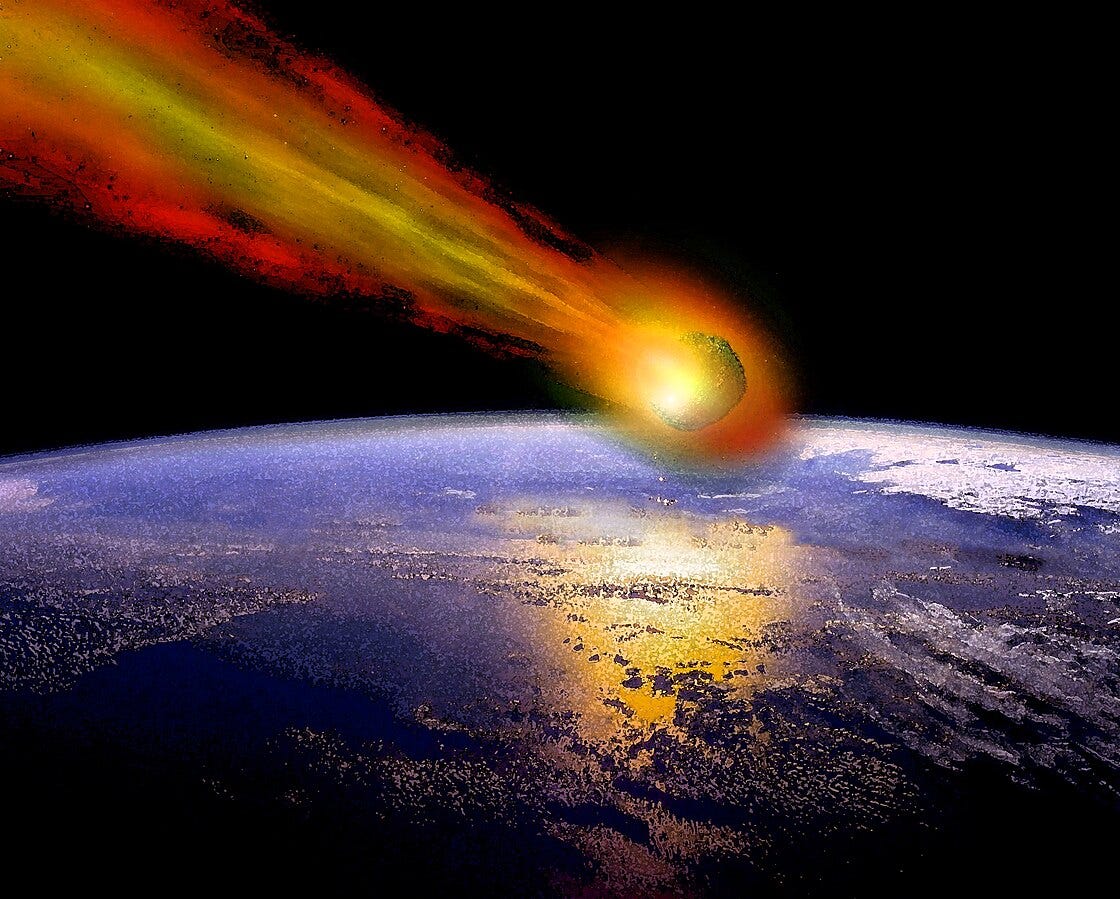Rock Stars: A quick introduction to meteorites
And how to find them in Antarctica
An audio version of this post is available on Substack and Spotify.
A few nights ago, as I was creating my nightly map of the few stars visible in my light-soaked neighborhood, I saw a clean white line streak past Mars in the eastern sky. It was like a cosmic raindrop, brilliant and liquid, flowing down the dark surface of interplanetary space.
If anyone had seen ALH84001 hurtle through Earth’s atmosphere 13,000 years ago, it might have looked similar.
Some terminology: Meteoroids—such as chunks of the Moon or Mars, asteroids, or other bits of rock traveling through space—sometimes enter the Earth’s atmosphere. When they do, they become meteors, like the shooting star I saw. The bright tail of light is not a star at all: it’s combustion caused by the space rock colliding with molecules in our atmosphere. An object in space can move at unimaginable speeds, because it is traveling through a void. When it reaches a planet with an atmosphere, though, it is suddenly jostled by molecules of oxygen, carbon dioxide, nitrogen, or whatever gases envelop the planet. The resulting friction causes the meteoroid to burn up into that streak of light we call a meteor.
Why don’t our own airplanes or rockets vaporize in that way? Speed. Most meteoroids enter the atmosphere at over 45,000 mph (72,000 km/hour), which is twenty times faster than the top airspeed of a Lockheed SR-71 Blackbird, and makes a jumbo jet look like it’s standing still. If planes moved at those speeds, everything on board would be vaporized in moments: when a comet from the Oort Cloud entered the atmosphere in 2013 at a blistering 161,000 mph (about 259,100 km/hour), it burned to nothing within several seconds.
If anything survives the meteor’s fiery descent through the atmosphere, that chunk of rock is a meteorite. Meteorites litter the Earth’s surface, many of them smaller than an infant’s fist, the barest remnant of the object that first entered the atmosphere. The largest known extant meteorite is almost 9 feet (2.7 meters) long and weighs over 60 tons. (Heftier ones have certainly struck our planet, but if a rock is still very large when it hits the Earth’s surface, it’s a problem. One possible scenario: the dinosaurs go extinct.)
Apart from their distinctive pock-marked surfaces (caused by melting as they blaze through the atmosphere), meteorites look very similar to Earth rocks. In the extremely unlikely event that one fell near your house, chances are good that you would never notice anything amiss…unless, like Robert Frost’s laborer in “A Star in a Stone Boat,” you tried to pick it up. Because rocks in space tend to be dense, with a higher concentration of iron than terrestrial rocks, they are surprisingly heavy.
Their iron-rich composition makes meteorites a boon for researchers, because iron-based ferromagnetic minerals hold traces of past magnetic alignments. If you want to understand the magnetic history of the solar system—or the galaxy, or the universe, or potentially habitable planets—you need iron from outer space. In the case of ALH84001, faint variations in tiny magnetic grains have allowed researchers to determine the history of Mars’s magnetic field—which used to protect the planet’s atmosphere and, by extension, its liquid water.
If a meteorite fell near your house, though, it would likely be exposed to rain, air pollution, microbes in the soil, and other forms of physical and chemical weathering. These factors can damage the information stored in the meteorite. For a beautifully preserved meteorite, you want a place that’s dry and less susceptible to pollution in the air, water, or soil.
Enter Antarctica.
Since 1976, teams from ANSMET (Antarctic Search for Meteorites) have recovered over 20,000 meteorites in the Antarctic. The frozen continent is an ideal place to recover meteorites, since bright white or blue ice makes the rocks easy to spot, while the dry conditions protect them from oxidation that might alter their chemistry and destroy the information scientists hope to glean.
Antarctic meteorite hunters also know where to go. As the ice streams moving across the East Antarctic Plateau flow towards the coast, some of the ice grinds up against the Transantarctic Mountains. Here, winds ablate the surface ice away, while deeper ice is brought to the surface—along with whatever is trapped inside it. These meteorite stranding zones are like your grandpa’s fishing holes: if you cast a rod there, something is likely to turn up. And since East Antarctica has been continuously glaciated for millions of years, rocks entrained in its ancient blue ice most likely did not come from Earth. They fell out of the sky.

Unfortunately, once they reach the Transantarctic Mountains, terrestrial rocks abound. At that point, it’s a sophisticated game of Who’s Who? to tell the space rocks apart.
It’s thanks to these methods that we were able to recover and study ALH84001, along with a wealth of other extraterrestrial rocks.





